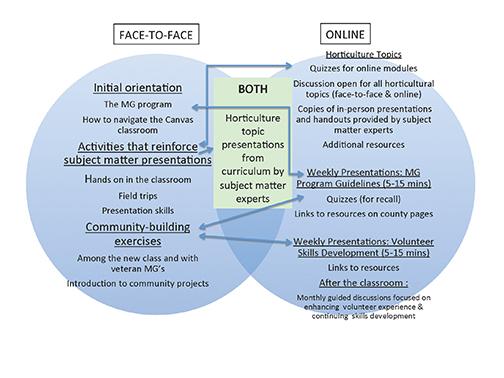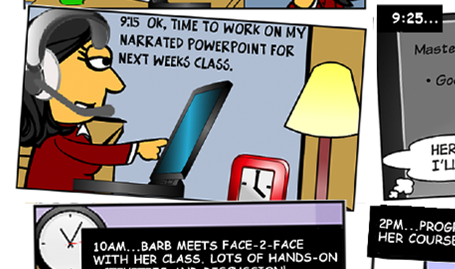 |
August 2016
|
August 2016 // Volume 54 // Number 4 // Ideas at Work // v54-4iw3
Hybrid Teaching in Extension: Learning at the Crossroads
Abstract
Extension clients' learning preferences are changing, with many increasingly going online for educational content. In response, Oregon State University Extension pilot tested a training program for Extension educators to explore hybrid teaching—a methodology that could provide more flexible access to a wider audience. Hybrid teaching offers a powerful blend of online and face-to-face instruction that could attract Extension educators—and administrators—to this pedagogical approach. The pilot training revealed both the promises and challenges of hybrid teaching.
Introduction
Extension clients' learning preferences are changing. The advent of widespread high-speed Internet connectivity, mobile devices, and advances in online pedagogy has disrupted traditional models of teaching and learning. To explore how Extension might respond to this challenge, we conducted an experiment using hybrid learning as an alternative approach to educational programming. At the heart of the experiment was a pilot effort to train, encourage, and support a small group of Extension faculty in the design and delivery of educational programs using a hybrid (also called "blended") approach. The training was loosely modeled on an existing on-campus faculty development program offered by the Oregon State University (OSU) Center for Teaching and Learning. Twenty-four OSU Extension faculty took part in two 8-week Extension Hybrid Learning Study Groups, offered in a hybrid format, facilitated by us in 2014 and 2015.
Hybrid Learning: What Is It?
A hybrid course includes regularly scheduled face-to-face classroom meetings explicitly integrated with significant online learning activities. "An onsite course becomes blended [hybrid] when online activities are designed to replace onsite sessions" (Stein & Graham, 2014, p. 12). (In this article, the term course refers to the many structured educational programs found in Extension, e.g., workshops, trainings, field tours.) A hybrid approach emphasizes active learning, stretches the learning space beyond the physical classroom, and facilitates robust interaction between instructors and learners both face-to-face and online.
A growing body of research (Bowen, Chingos, Lack, & Nygren, 2012; Griffiths, Chingos, Mulhern, & Spies, 2014; Picciano, Dziuban, & Graham, 2014) strongly supports the efficacy of hybrid teaching and learning. Significantly, empirical studies comparing online, blended, and purely face-to-face teaching formats have shown that student performance in courses that integrated face-to-face and online instruction was better than in courses having only face-to-face interaction (Means, Toyama, Murphy, Bakia, & Jones, 2009). Increasingly, standards and best practices are being identified to guide educators in the application of hybrid approaches (McGee & Reis, 2012; Stein & Graham, 2014).
A 2009 study of technology adoption in OSU Extension found that the use of a blended approach held interest with Extension personnel (Diem, Hino, Martin, & Meisenbach, 2011). Blended learning builds on Extension's strengths while responding well to current financial pressures and the need for greater exposure (Rich et al., 2011). Hybrid courses are inherently modular, shareable, and easily repurposed and adapted to fit the variety of educational programs on today's Extension learning landscape.
Our Approach: Life Imitates Art
Our goal was to develop Extension faculty capacity to design and deliver hybrid educational programs. We solicited participants statewide for two Extension Hybrid Learning Study Groups, one in spring 2014 and one in winter 2015, offering a small stipend ($300) for successful completion. A memorandum of understanding signed by each participant and his or her supervisor confirmed the 30-hr time commitment and two deliverables: a detailed course plan for delivery of a hybrid educational program and an associated prototype hybrid learning module. Participants represented a wide range of Extension program areas, from forestry to 4-H.
The study groups were themselves conducted in a hybrid format as faculty learning communities, each involving online study and interaction bookended by two extended (half- to full-day) on-campus meetings. The first meeting introduced the purposes and format of the study group, covered fundamentals of blended learning, and discussed preliminary hybrid course ideas of the participants. The final meeting was a capstone event, with participants presenting their hybrid program plans. The online portion of the study group was delivered through weekly learning modules and involved readings, videos, online tool demos, discussion boards, and blogging. The first study group used the Blackboard learning management system (LMS); the second used Canvas as the result of a campus transition to that LMS. We also included optional online synchronous sessions through Google Hangouts and Canvas Conferences.
The approach was to identify effective blended learning practices as a group while each participant (a) developed a detailed plan for delivering an Extension course in hybrid format and (b) built a sample learning module for the course. A key element was "iterative sharing" in which each participant described/explained his or her planned hybrid approach to the group repeatedly in various ways—in face-to-face meetings, in online synchronous sessions, in online discussions, in the mix map (see Figure 1 for example), and in the group blog—throughout the 8 weeks, getting feedback from the facilitators and their peers each time.
Figure 1.
Mix Map Worksheet Outlining Proposed Online and Face-to-Face Components of a Hybrid Master Gardener Training
This mix map worksheet drafted by a study group participant outlines the proposed online and on-the-ground (face-to-face) components of a hybrid master gardener training. The arrows show connections between learning activities. The central "BOTH" area indicates content that will be delivered both online and face-to-face.
Taking the Hybrid Path: Forces at Work
Given the relative newness of hybrid teaching in Extension, we conducted a force field analysis (http://www.extension.iastate.edu/communities/force-field-analysis) with the first study group to capture the group members' perceptions of the opportunities and challenges that may arise in applying hybrid teaching in an Extension setting (Figure 2).
| FORCES FOR | Hybrid Teaching in Extension | FORCES AGAINST |
| Efficient for faculty (4) | Upfront development time (5) | |
| Broader audience (diverse, new demographics, easier access) (4) | Inertia (4) | |
| Convenient for learners (3) | Limited expertise in online delivery among Extension faculty (4) | |
| Responds to changes in client demographics (i.e., younger digital natives) (3) | Skepticism of administration, faculty, and learners (3) | |
| Scalable (4) | Not all programs are suited for hybrid approach (3) | |
| Cost effective (4) | Technology access and skills not available to everyone (3) | |
| Greater adaptability, both regional and national (3) | ||
| Meets growing audience demand for online resources (3) | ||
| Encourages resource sharing (3) | ||
| Ability to chunk content (3) | ||
| Supported by existing technology (2) | ||
| Total score +36 | Total score -22 |
Overall, this exercise showed that our participants were very optimistic about the potential for the hybrid approach in their educational programming areas but also predicted real-world hurdles to overcome, as illustrated in a video from one of the Extension Hybrid Learning Study Group sessions (https://www.youtube.com/watch?v=aBvM8fKis-Q&feature=youtu.be).
On the basis of the force field analysis, we developed "A Day in the Life of Blended Barb" (Figure 3, http://blogs.oregonstate.edu/extensionhybrid/2015/01/30/day-life-blended-barb/)—a cartoon depiction of an imagined typical day of an Extension educator using the hybrid format. This graphic has proved useful in enlisting additional participants and informing administrators.
Figure 3.
A Day in the Life of Blended Barb
Conclusions
We and the study group participants agreed that hybrid teaching has a major role to play in Extension educational programming. Currently, there is very little in the literature regarding the use of hybrid/blended learning in Extension. It is our hope that similar efforts by others could lead to a greater shared understanding of best practices for implementation of hybrid approaches. Our pilot program revealed that implementing hybrid courses presents challenges but also offers potential rewards, including reaching larger and untapped audiences, realizing cost savings through increased faculty efficiency, sharing modular teaching resources, reducing travel time, and engaging Extension learners in a manner that may better reflect emerging lifelong learning preferences.
References
Bowen, W. G., Chingos, M. M., Lack, K. A., & Nygren, T. I. (2012). Interactive learning online at public universities: Evidence from randomized trials. Retrieved from http://www.sr.ithaka.org/research-publications/interactive-learning-online-public-universities-evidence-randomized-trials
Diem, K., Hino, J., Martin, D., & Meisenbach, T. (2011). Is Extension ready to adopt technology for delivering programs and reaching new audiences? Journal of Extension [online], 49(6) Article 6FEA1. Available at: http://www.joe.org/joe/2011december/a1.php
Griffiths, R., Chingos, M., Mulhern, C., & Spies, R. (2014). Interactive online learning on campus: Testing MOOCs and other platforms in hybrid formats in the University System of Maryland. New York, NY: Ithaka S+R. Retrieved from http://sr.ithaka.org/research-publications/interactive-online-learning-on-campus
McGee, P., & Reis, A. (2012). Blended course design: A synthesis of best practices. Online Learning Consortium, 16(4). Retrieved from http://onlinelearningconsortium.org/jaln_full_issue/volume-16-issue-4-june-2012/
Means, B., Toyama, Y., Murphy, R., Bakia, M., & Jones, K. (2009). Evaluation of evidence-based practices in online learning: A meta-analysis and review of online learning studies. U.S. Department of Education Office of Planning, Evaluation, and Policy Development, Policy and Program Studies Service. Retrieved from https://scholar.google.com/scholar?q=evaluation+of+Evidence-Based+Practices+in+Online+LearningA+Meta-Analysis+and+Review+of+Online+Learning+Studies&hl=en&as_sdt=0&as_vis=1&oi=scholart&sa=X&ved=0CBwQgQMwAGoVChMIqZiJsYGTyAIVkpSICh0SHQDN
Picciano, A. G., Dziuban, C. D., & Graham, C. R. (Eds.). (2014). Blended Learning: Research Perspectives, Vol. 2. New York, NY: Routledge.
Rich, S. R., Komar, S., Schilling, B., Tomas, S. R., Carleo, J., & Colucci, S. J. (2011). Meeting Extension programming needs with technology: A case study of agritourism webinars. Journal of Extension [online], 49(6) Article 6FEA4. Available at: http://www.joe.org/joe/2011december/a4.php
Stein, J., & Graham, C. (2014). Essentials for Blended Learning. New York, NY: Routledge.




